February, 2015.
Chapultepec, Mexico City
Stage of altitude sickness: early symptoms
I am feeling a little shaky from the double expresso I just drank to rid myself of the unusual feelings of lethargy hanging over me. I am relieved to be standing in the cool, dark, air-conditioned expanse of the Museo Nacional de Antropologia – the heat outdoors was not helping things. I am blissfully lost in endless artefacts relating to different areas of Mexico and indigenous tribes – from huge tribal headdresses to ritual objects, costume and architectural remains. My fuzzy head and lower-than-usual attention span mean I am not really reading captions next to the exhibits, but rather drifting around letting things of visual interest draw me towards them.
…Which is how I find myself standing in front of a series of glass cabinets containing what look like illustrated manuscripts, on thick, rough paper. On closer inspection of these pages I discover an utterly beautiful, minute world of hand-drawn, coded visual symbols. I momentarily forget my caffeine shakes and foggy, aching brain, and get sucked into a world articulated the ancient way – through image alone. My mind leaps to life, creating imaginary stories and connections between the symbols, exhilarated by the infinite possibilities.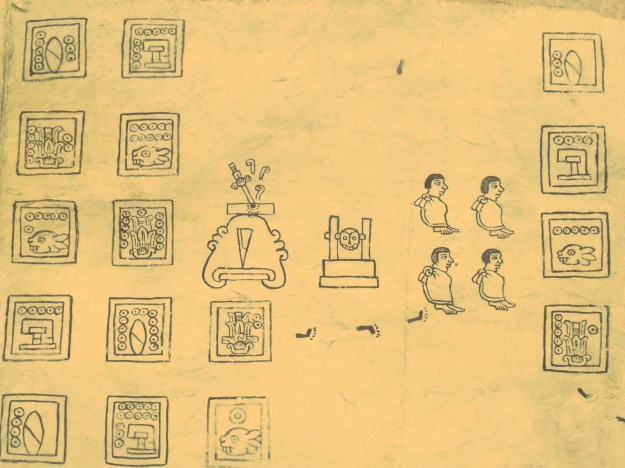
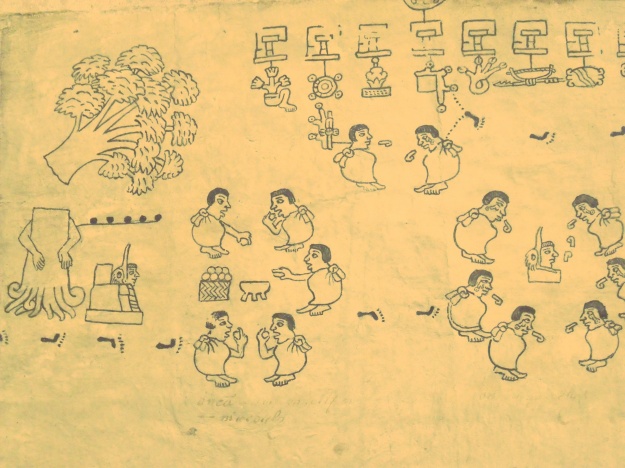
I discover that these are Codices – manuscripts created by pre-Columbian societies, which document all that is important to them – their belief systems, myths, practices, rituals – although much of the content of these codices is not understood today. They were painted onto various materials ranging from nopal cactus to fig tree bark, and can be several metres long.
These codices document the world of the societies which were subdued after the conquest of the Americas – and most of them were destroyed by the conquistadors. Bishop Diego de Landa ordered the elimination of many codices in 1592, stating: “We found a large number of books in these characters and, as they contained nothing in which were not to be seen as superstition and lies of the devil, we burned them all, which they regretted to an amazing degree, and which caused them much affliction.”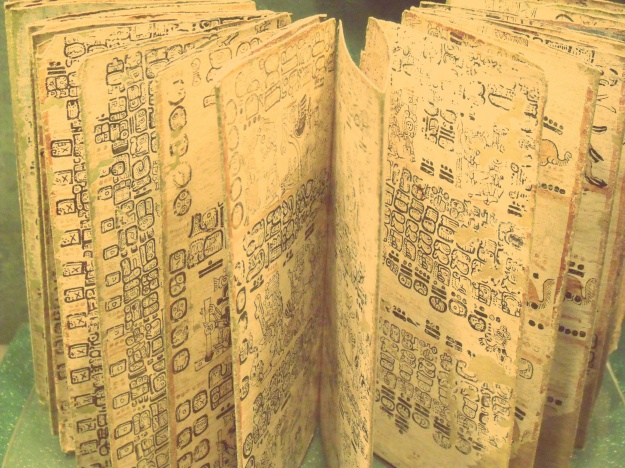
I am endlessly fascinated by this pattern – throughout continents and cultures it seems that our original written ‘folk’ languages, which connected people to their land, their beliefs and their communities, was an image-based language. And in all of these cultures there seems to be a point in history when a new social order arrives and co-ordinates a cleansing of these images and symbols, deeming them dangerous and malevolent, and replacing them with the written word. But the mystery of worlds created through symbolic language alone never fails to cry out for my attention. Definitely a line of investigation to be continued…
Tepoztlan, near Mexico City
Stage of altitude sickness: mid-flow
We just about managed the one hour journey on public transport to the Southern-most bus terminal of Mexico City. The winding bus route up into the mountains which surround the city, and then down into the valleys beyond, was just about tolerable, even with the deafening Shakira videos. And now we are in the sleepy refuge of Tepoztlan, with its clean air and neighbouring sacred mountain. Here, the city folk told us, our altitude sickness will get better.
On our last day here we finally feel we have the strength to sit in a café and maintain an adequate conversation with a stranger. Following the connection forged via a telephone number scrawled on a scrap of paper, we sit in Café Amor and wait for Sergio, the puppeteer. As the minutes past our arranged meeting time pass by, my strength begins to fade once more…the simultaneous brain fuzz and headache are winning their daily battle. Finally, a scruffy, wiry, bearded chap with a broad grin bounds into the café – it must of course be Sergio. His chirpiness and energy are infectious, and I instantly feel a little better. With my Spanish companions helping as language intermediaries, Sergio tells the story of how he came to be a puppeteer, via a romance with an Argentinian actress, an impoverished tour through her country and a store room of abandoned puppets along the way.
Nowadays he is based between Tepoztlan and Mexico City with his company, Teatro Artimanas, which specialises both in large scale puppets and teatro en miniature, ‘miniature theatre’ – sometimes combining the two together, with inspiring results…
Sergio invites us to camp up on his land in the mountains and have a barbeque – with our delicate dispositions we have to decline, and he bounds off just as he arrived, having scrawled down the address of Mexico City’s Teatro Tinglado, and instructed me to ‘ask for Pablo’.
Coyoacan, Mexico City
Stage of altitude sickness: improving
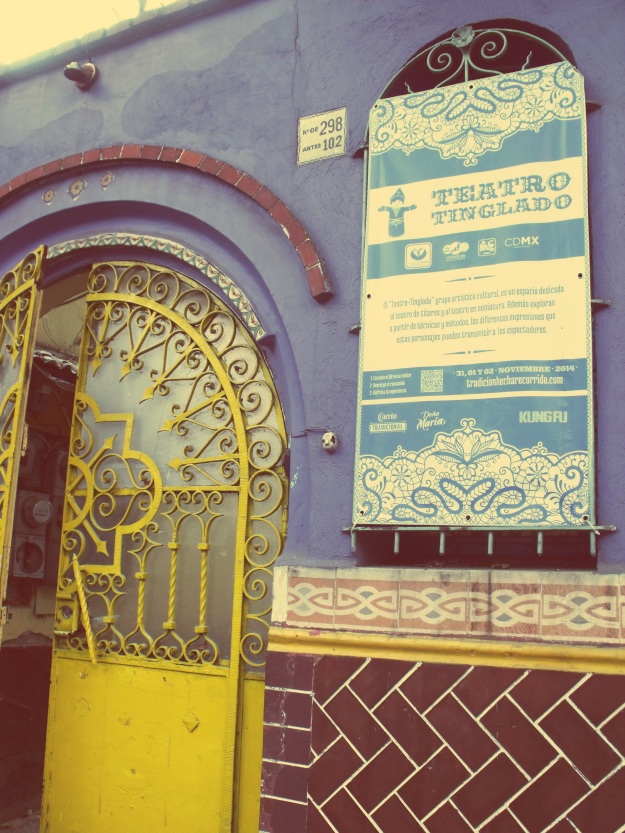
I am waiting for the man called Pablo in a leafy courtyard in Coyoacan, the district to the South of Mexico City where Frida Kahlo’s Casa Azul lies, a few blocks away. I followed a street of gorgeously aged colonial houses and tall trees for what felt like forever, until finally I arrived at the entrance to Teatro Tinglado, (also known as Francisco Sosa 298) home to Coyoacan’s puppetry and ‘miniature theatre’ community. As I sit here, a couple of the theatre’s artists chat to me whilst carving a large puppet’s face out of foam.
Pablo arrives, fashionably late. He warm and welcoming, and takes me on a tour of this utterly idyllic little leafy, backstreet puppet theatre. Before long, my curiosity is piqued by a back room filled with boxes, some of them opened to reveal intricate elements of miniature theatres and sets. I catch glimpses of multi-coloured folk art treasures, and I’m hungry to investigate further…
Firstly, Pablo points to the framed posters on the wall, advertising past shows. Many of them mention Mireya Cueto – Pablo’s mother, a puppeteer and puppet-maker, and original founder of the theatre. Pablo speaks of his mother with immense pride (she passed away in 2013), and later research reveals that Mireya’s legacy stands beside that of Frida Kahlo – a truly creative force who used puppetry to create her own ‘universe’ of myth and story, in celebration of her Mexican heritage.
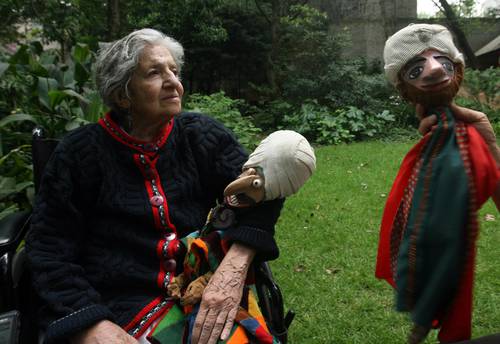
Now, back to this intriguing puppetry store room. Pablo starts rummaging through boxes and assembling dismantled parts. I feel I am standing in a folk art grotto of colourful, ornately decorated theatrical objects – elaborate little proscenium arch frames, hand-painted scenic panels, several theatrical automata… My guide is patient with my mild hysteria, answering questions and offering back-stories. 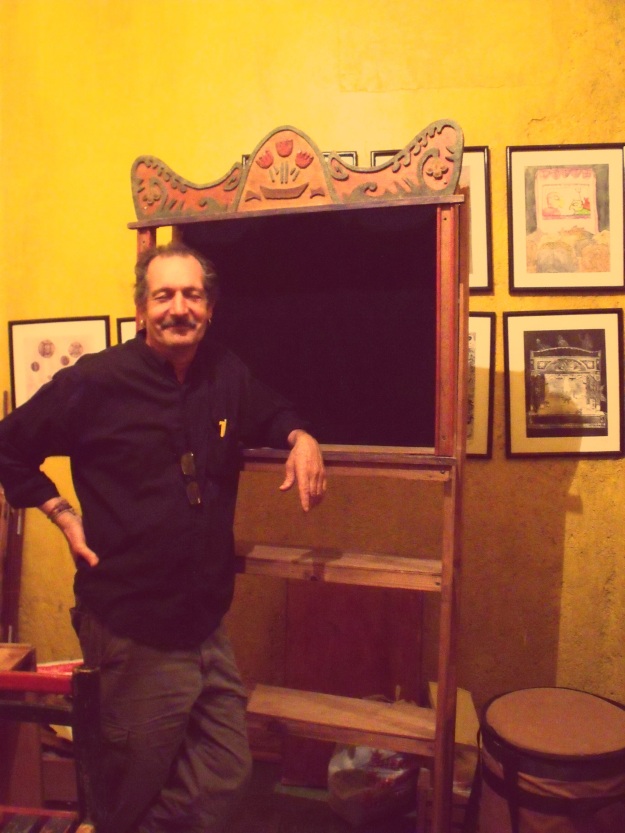
But my hysteria reaches its pinnacle when the final theatrical treasure is unveiled. For ten minutes, Pablo joins together various carved, wooden elements painted with bold Aztec-style patterns and symbols. There are frames of scenery, 2D jointed puppets, what look like conveyor belts of tiny wooden creatures…Finally, this wondrous theatrical mechanism is assembled, and Pablo brings it to life via handles, cranks and pulleys. The figures dance, the creatures spin around on their belt, the snake wriggles…its an Aztec ritual creation, vibrant and humming with life. I am blown away.
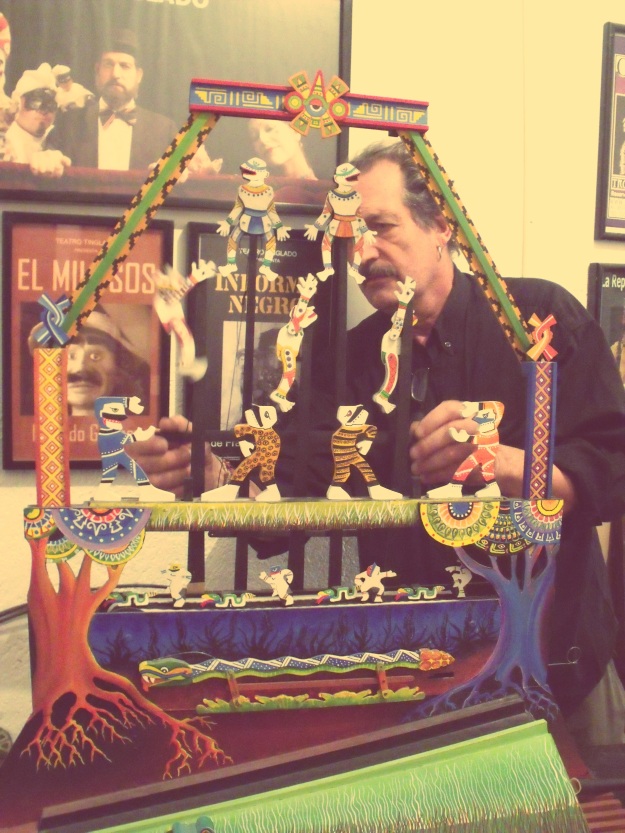
Roma, Mexico City
Stage of altitude sickness: pretty much gone
I am in a small studio, clean and shiny with mirrored walls and a lino floor. I am sitting cross-legged in a circle with ten or so other people. In the middle is a large dish filled with tinted swimming goggles, which we are about to each put on after we have received our introduction and briefing.
I am about to ‘attend’ a performance by Sensorama, a theatre company which operates from this series of studio rooms on the 9th floor of a tower block. Sensorama specialise in ‘sensory’ theatre based on Mexican indigenous traditions and ceremonies – the performance I am about to enrol upon is called Cosas que solo de Muerte se saben (‘things which we can only know through death’) but their other theatrical experiences include Cuatro Elementos – Cantos Indigenas (‘four elements – indigenous chants’). Our guide wears a Sensorama t-shirt and gives us our briefing – this bright studio makes me feel like I am about to go for a spa treatment. I put on my goggles, which reduce my vision to blurry shapes and shadows. We stand up, forming a line, our hand on the shoulder of the person in front of us. The lights dim, and we are led through a doorway.
What follows is a strange journey into death, through sound, music, colour, sensory touch, smell and taste. We enter a space, and anonymous facilitators guide us into the right positions – sitting, then lying down. Music and a disembodied voice lead the process – I don’t always follow what is being said. Soon it becomes clear what is happening – we are on our deathbeds. A veil is placed over our heads and a rose placed into our clasped hands. There is the sound of mourners sobbing. This is not easy-going stuff.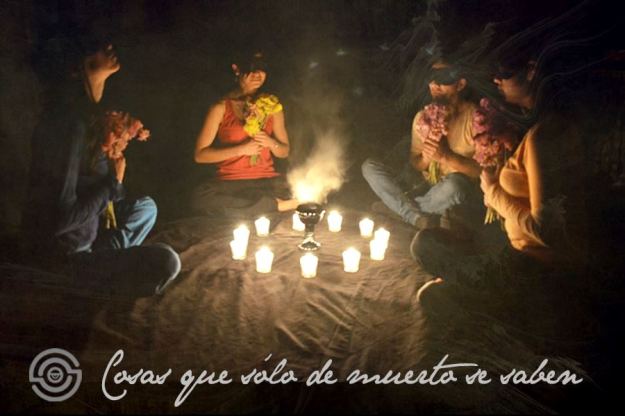
It becomes clear that this is not where it ends. The voice continues to talk…but I feel glad that I don’t understand much of what’s being said. My language barrier means that there is no risk of hearing words which are too prescriptive – I am able to interpret the experience in my own way. After the death, the sobbing, the shawl over my head, my eyes are being engulfed by golden light and the sound of rushing water all around me. Regardless of your perspective on death, this is an uplifting, open-ended metaphor.
Back in the briefing room, my fellow theatre-goers and I remove our goggles. They are a wide range of ages and backgrounds, some theatre types and some not, and we are all given a chance to reflect on the experience. My Spanish language skills get another workout as I listen to these Mexicans, many of whom are totally new to this type of non-conventional theatre. Its the feedback of some of the older participants which sticks with me – a man with a long term fear of flying, for example, who quietly contemplates what it is to take a risk.
Airport, Mexico City
Stage of altitude sickness: a distant memory
Persistent headaches, lethargy and, at times, swollen eyes, almost threatened to send me running from Mexico City. But in the end, altitude sickness lost the battle…against a medicinal cocktail of indigenous traditions celebrating life and death, joyous folk art colours, and inventive, ancient ways of telling stories.
I think I will be back.

I loved the Art Museums there and the Rivera Mural in the government building off the main Zocalo is extraordinary. Will you be there at the end of the month for El dia de muerte? It’s brilliant. I also loved Monte Alban near Oaxaca. Great to hear of your adventures. TGx
Thanks for responding Tony! Yes, I was blown away by the Riviera murals in the Palacio Nacional. Alas this was back in February – both times I’ve visited Mexico I’ve missed the Dia de los Muertos…There was so much more to discover just in Mexico City, and ironically I only had about two days of good health out of the two weeks I was there! So yes, must go back. 🙂